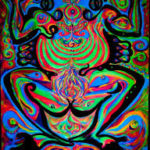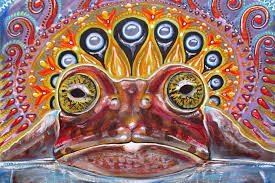Happy New Year! I’m sure we’re all hoping that this year brings renewed optimism, through the creative, caring, and sensible use of all that’s available in this era of rapid change. In that spirit, I discuss my thoughts about “good drugs” and share my recent experience of DMT.
My twin boys are now thirteen, so they are approaching the age at which they’re likely to be exposed to drugs of all sorts. Like most parents, Isabel and I are concerned. We’re trying to find the right preparation and the right logic to steer them away from drug experiences that will likely be harmful. What can we say that provides guidance, not prohibition? Should we try to persuade the boys to avoid all drugs? Not a very useful strategy, says Carl Hart, and I agree. Not only would they probably dismiss our counsel and ignore our views on drugs completely — after all, we’d simply be displaying our biases. But on this point I follow Sam Harris. Somewhere in his book, Waking Up — A Guide to Spirituality without Religion, he says something like this: (don’t quote me — this is from memory) I hope my kids will never tell me they’ve experimented with meth or heroin. But I also hope they won’t tell me that they’ve avoided the psychedelics with equal fervor. I like Sam Harris. I like his approach to mindfulness, consciousness, and living with awareness. I’ve also just begun his guided meditation app. I highly recommend it.
There are so many kinds of drugs we could talk about with our kids, and the legal system provides almost no help when it comes to sorting them according to potential risk. After all, alcohol and tobacco are the most hazardous of substances, statistically, and they’re both legal. My intuition is to divide non-medical (“recreational”?) drugs into three categories:
- Those you should never ever touch: methamphetamine, heroin, crack cocaine. Besides the risk of overdose with heroin and psychosis or stroke with psychostimulants, all three drugs are highly addictive. I want to scare my kids appropriately, using my own past experiences for all they’re worth.
- Those you’d be best to avoid but probably won’t harm you if you explore cautiously, use occasionally, and learn about the risks: nonaddictive party drugs like ecstasy (MDMA) and ketamine.
- Those that really are okay if used appropriately: including alcohol, an aspect of human social rituals for roughly ten thousand years…but more interestingly, the psychedelics. If you are not vulnerable to psychosis or other severe mental health issues, then psychedelics can be beneficial in the pursuit of self-actualization or just exploring unique aspects of mind, consciousness, and reality. Of course, tread cautiously. Don’t go into these waters without guidance, companionship, and some degree of knowledge. But these drug experiences are among the adventures available to our age.
The psychedelics were epitomized by LSD in my generation. Psilocybin (magic mushrooms) and mescaline were also quite common. For young people in the current era, psilocybin is still frequently used. More recent additions include ayahuasca and other forms of DMT. These DMT compounds might be most  attractive (and challenging!) to today’s intrepid psychonaut. And by the way, psychonaut is a real word; it refers to the exploration of altered states, including but not limited to “mind-altering” drugs.
attractive (and challenging!) to today’s intrepid psychonaut. And by the way, psychonaut is a real word; it refers to the exploration of altered states, including but not limited to “mind-altering” drugs.
 There’s much to say about the ritualistic use of DMT by aboriginal cultures, the shamanic element, the social contexts considered helpful and supportive, and the limited research conducted so far. This Wikipedia page is a good start. It’s also important to note that psilocybin and MDMA are now being used by licensed psychiatrists to help their patients overcome anxiety, depression, addiction, and other unfortunate habits of mind (see Michael Pollan).
There’s much to say about the ritualistic use of DMT by aboriginal cultures, the shamanic element, the social contexts considered helpful and supportive, and the limited research conducted so far. This Wikipedia page is a good start. It’s also important to note that psilocybin and MDMA are now being used by licensed psychiatrists to help their patients overcome anxiety, depression, addiction, and other unfortunate habits of mind (see Michael Pollan).
But you can read all this on the net. Let me tell you about my own recent experience.
I wrote about my first ayahuasca trip in this blog a few years ago. After five or six ceremonies, I decided that’s enough. The insights were profound, the hallucinations penetrating and beautiful, but running to the toilet every half-hour got old.
 More recently, I heard an intriguing description of a trip with The Toad. Bufo Alvarius secretes a substance (5-MeO-DMT) that is dried and then smoked in a glass pipe. The toad is not killed but respectfully released after its DMT is collected. The trip is supposed to be rapid (5-25 minutes) and intense. Efficient, right? So I joined a friend in the UK for my introduction. We had a shaman usher us into this strange world, a short, tough-talking Brit from northern England who’d spent a prolonged period in the Sonoran Desert learning about Bufo from the natives who used it. John was a no-nonsense guy radiating expertise as well as compassion. His Tibetan bowls, drums, and feathers were ready to accompany us into, through, and out of the hallucinatory state.
More recently, I heard an intriguing description of a trip with The Toad. Bufo Alvarius secretes a substance (5-MeO-DMT) that is dried and then smoked in a glass pipe. The toad is not killed but respectfully released after its DMT is collected. The trip is supposed to be rapid (5-25 minutes) and intense. Efficient, right? So I joined a friend in the UK for my introduction. We had a shaman usher us into this strange world, a short, tough-talking Brit from northern England who’d spent a prolonged period in the Sonoran Desert learning about Bufo from the natives who used it. John was a no-nonsense guy radiating expertise as well as compassion. His Tibetan bowls, drums, and feathers were ready to accompany us into, through, and out of the hallucinatory state.
We met in a church hall, chilly and unadorned. But it was enough. John and his helper arranged two padded bed-rolls which you sat against at first and then lay back on when the DMT hit your nervous system. I’d been feeling  afraid of this moment for days. My friend spoke about “ego death” — leaving your personality behind, essentially dying as an individual and becoming connected with the rest of the universe intimately but without control. Sure, I was scared. “Ego death” has the word “death” in it.
afraid of this moment for days. My friend spoke about “ego death” — leaving your personality behind, essentially dying as an individual and becoming connected with the rest of the universe intimately but without control. Sure, I was scared. “Ego death” has the word “death” in it.
For some reason, my fear disappeared the day of the event. I felt ready. By mutual consent, I went first. I was doused in tobacco smoke (an American native ritual) and cleansed of badness with the swoosh of a feather. I sat on the bed-roll. John ordered me to exhale completely, then held the stem of a glass pipe to my lips and lit it from below. Inhale, he said. More, more, keep going! And I did, until it felt like my  lungs would burst. And then the room began to dissolve before my eyes. All of its features simply faded to colourful outlines and then…nothing at all. Strong hands helped me to lie back. Close your eyes now — I could still hear his voice. But I wasn’t in the room anymore.
lungs would burst. And then the room began to dissolve before my eyes. All of its features simply faded to colourful outlines and then…nothing at all. Strong hands helped me to lie back. Close your eyes now — I could still hear his voice. But I wasn’t in the room anymore.
Where was I? Of course it’s nearly impossible to describe. Something like a limitless pink space full of fluctuating colours and…feelings. It was a space of pure emotion. I felt great joy, gratitude that the universe would welcome me so easily. “Marc” meant nothing anymore, but I could still record my experience consciously. And right in the middle of all that joy there was a sort of black hole, called “anguish.” It held the greatest depths of despair, and I recognized a direct trajectory that’s extended through my life, from childhood to the present. The message, if I can call it that, was simple: this is the part of my experience that I thought I could not bear, that has always terrified me. Yet here it is, and it’s just…a feeling. Just loss. This truth seemed incredibly important, and when I came back to the room, smiling up at my companions, groggy and googly-eyed, it was still with me, undiminished.
I don’t want to get into deep speculation as to what I learned from Bufo. But I’m grateful for the awareness it lent me. For weeks I began my day with a simple sense of acceptance. It seemed that nothing in my emotional space needed to be hidden, or deleted, or modified. It seemed (and often still does) that my sense of reality has no preordained limits, and there is something that can be perceived, something caring and supportive, in the fabric of consciousness itself.
Perhaps in the coming year, the coming years, drugs like DMT will help us discard our preoccupation with our selves and trade our individuality for a connectedness that includes our fellow humans and the planet we share.

Leave a Reply